HINDU MARATHA
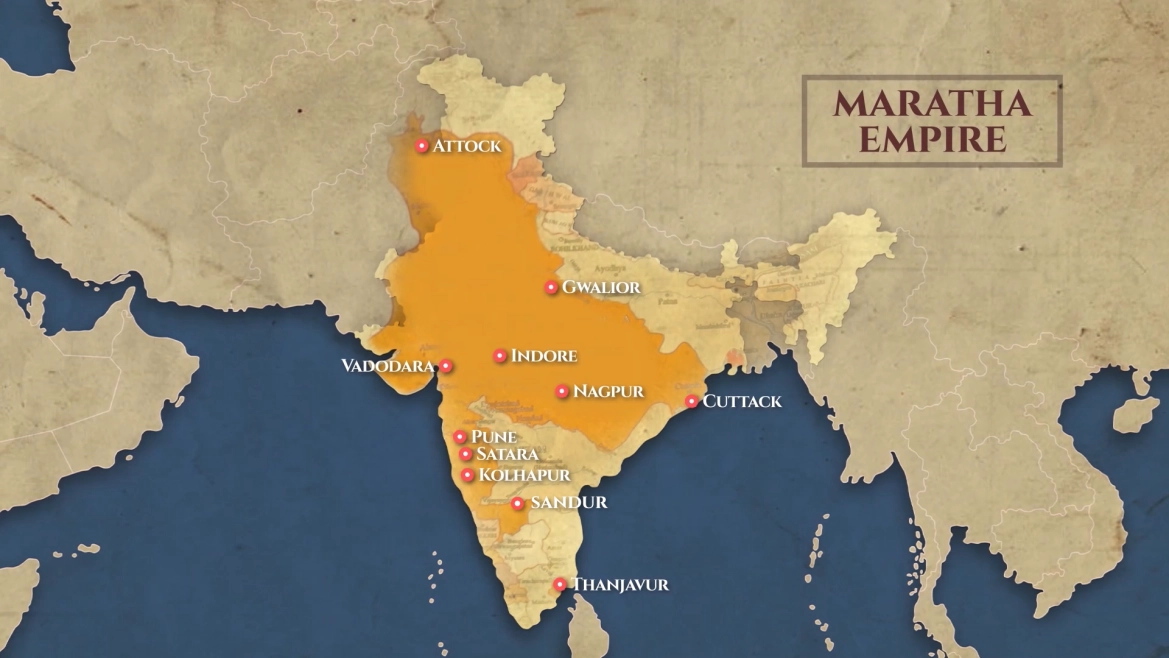
The origins of the Maratha Empire can be traced back to a series of rebellions led by Chhatrapati Shivaji Maharaj against the rule of the Bijapur Sultanate and later the Mughal Empire. Based on the principle of Hindawi Swarajya, he carved out an independent Maratha kingdom with Raigad as the capital. In 1674, he was crowned Chhatrapati (sovereign) of the new Maratha Kingdom after successfully defending it from Mughal incursions. At the time of his death, the kingdom was defended by a series of forts and well equipped naval establishments. By the time of his grandson’s rule in the early 18th century, the kingdom had increased its size and transformed into a full-fledged empire. Chhatrapati Shivaji Maharaj (born on February 19, 1630) was succeeded by his eldest son Sambhaji (also known as Shambhu Raje) in 1681. He continued the expansion policy of his father defeating the Portuguese and Chikka Deva Raya of Mysore to expand his borders. These developments were alarming enough for Mughal Emperor Aurangazeb (born on 3rd November 1618) to launch an expedition against the Marathas. In the 8 years of wars that followed, Shambhu Raje (born on May 14 1657) fought Aurangzeb all along the Deccan region, never losing any battle or his forts. Then in 1689, Sambhaji was ambushed by Mughal forces while on his way to meet his commanders at Sangameshwar. He was imprisoned and later executed by Aurangazeb to demoralise the Maratha forces, but they still fought on. Aurangazeb later proceeded to occupy the capital of Raigad, holding the family of Chhatrapati Sambhaji hostage. Sambhaji’s half-brother Rajaram was crowned Chhatrapati in 1690, the coronation had taken place at Jinji fort in modern-day Tamil Nadu, assuming the regency for the seven-year-old son of Shambu Raje, Shahu. Aurangzeb continued in his attacks against the Marathas and even caused Junji fort after three attempts. Chhatrapati Rajaram escaped to Berar and died at Sinhagad in Pune in 1700.
CHATRAPTI SHIVAJIRAJE BHOSALE
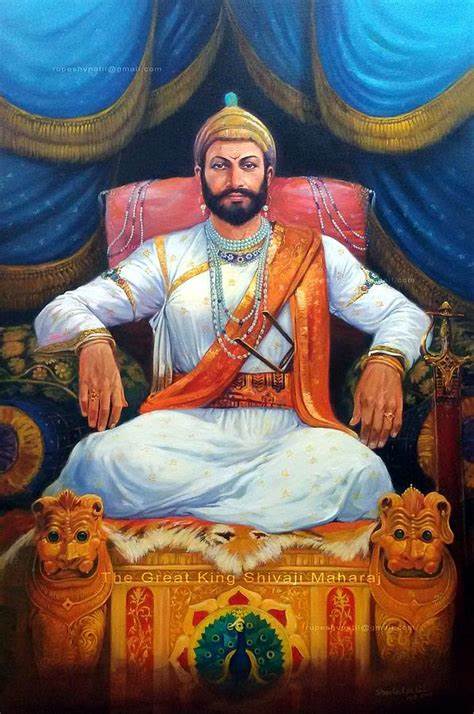
Shivaji (1627–1680) was a Maratha aristocrat of the Bhosale clan who is the founder of the Maratha empire.[3] Shivaji led a resistance to free the people from the Sultanate of Bijapur in 1645 by winning the fort Torna, followed by many more forts, placing the area under his control and establishing Hindavi Swarajya (self-rule of Hindu people[8]). He created an independent Maratha kingdom with Raigad as its capital[23] and successfully fought against the Mughals to defend his kingdom. He was crowned as Chhatrapati (sovereign) of the new Maratha kingdom in 1674. Shivaji had two sons: Sambhaji and Rajaram, who had different mothers and were half-brothers. In 1681, Sambhaji succeeded to the crown after his father's death and resumed his expansionist policies. Sambhaji had earlier defeated the Portuguese and Chikka Deva Raya of Mysore. To nullify the alliance between his rebel son, Akbar, and the Marathas,[26] Mughal Emperor Aurangzeb headed south in 1681. With his entire imperial court, administration and an army of about 500,000 troops, he proceeded to expand the Mughal empire, gaining territories such as the sultanates of Bijapur and Golconda. During the eight years that followed, Sambhaji led the Marathas. In early 1689, Sambhaji called his commanders for a strategic meeting at Sangameshwar to consider an onslaught on the Mughal forces.[citation needed] In a meticulously planned operation, Ganoji and Aurangzeb's commander, Mukarrab Khan, attacked Sangameshwar when Sambhaji was accompanied by just a few men. Sambhaji was ambushed and captured by the Mughal troops on 1 February 1689. He and his advisor, Kavi Kalash, were taken to Bahadurgad by the imperial army, where they were executed by the Mughals on 21 March 1689.[27] Aurangzeb had charged Sambhaji with attacks by Maratha forces on Burhanpur.[28]
Combat with Afzal Khan(32datach bokad)
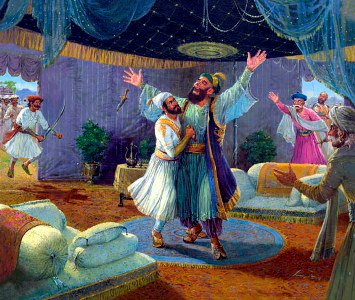
Adilshah was displeased at his losses to Shivaji's forces, which his vassal Shahaji disavowed. Having ended his conflict with the Mughals and having a greater ability to respond, in 1657 Adilshah sent Afzal Khan, a veteran general, to arrest Shivaji. Before engaging him, the Bijapuri forces desecrated the Tulja Bhavani Temple, holy to Shivaji's family, and the Vithoba temple at Pandharpur, a major pilgrimage site for the Hindus.[35][36][37] Pursued by Bijapuri forces, Shivaji retreated to Pratapgad fort, where many of his colleagues pressed him to surrender.[38] The two forces found themselves at a stalemate, with Shivaji unable to break the siege, while Afzal Khan, having a powerful cavalry but lacking siege equipment, was unable to take the fort. After two months, Afzal Khan sent an envoy to Shivaji suggesting the two leaders meet in private outside the fort to parley.[39][40] The two met in a hut at the foothills of Pratapgad fort on 10 November 1659. The arrangements had dictated that each come armed only with a sword, and attended by one follower. Shivaji, suspecting Afzal Khan would arrest or attack him,[41][b] wore armour beneath his clothes, concealed a bagh nakh (metal "tiger claw") on his left arm, and had a dagger in his right hand.[43] The precise transpirings are not recoverable to historical certainty and remains enmeshed with legends in Maratha sources; however, they agree upon the fact that the protagonists landed themselves in a physical struggle which would prove fatal for Khan.[c] Khan's dagger failed to pierce Shivaji's armour, but Shivaji had him disemboweled; he then fired a cannon to signal his hidden troops to attack the Bijapuri army.[45] In the ensuing Battle of Pratapgarh fought on 10 November 1659, Shivaji's forces decisively defeated the Bijapur Sultanate's forces. More than 3,000 soldiers of the Bijapur army were killed and one sardar of high rank, two sons of Afzal Khan and two Maratha chiefs were taken prisoner.[46] After the victory, a grand review was held by Shivaji below Pratapgarh. The captured enemy, both officers and men, were set free and sent back to their homes with money, food and other gifts. Marathas were rewarded accordingly
Siege of Panhala
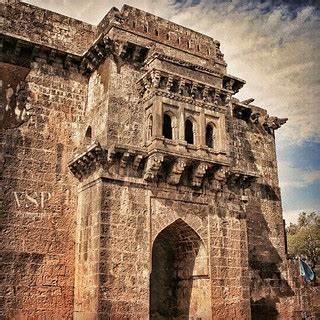
Having defeated the Bijapuri forces sent against him, Shivaji's army marched towards the Konkan and Kolhapur, seizing Panhala fort, and defeating Bijapuri forces sent against them under Rustam Zaman and Fazl Khan in 1659.[47] In 1660, Adilshah sent his general Siddi Jauhar to attack Shivaji's southern border, in alliance with the Mughals who planned to attack from the north. At that time, Shivaji was encamped at Panhala fort with his forces. Siddi Jauhar's army besieged Panhala in mid-1660, cutting off supply routes to the fort. During the bombardment of Panhala, Siddi Jauhar purchased grenades from the English at Rajapur to increase his efficacy, and also hired some English artillerymen to assist in his bombardment of the fort, conspicuously flying a flag used by the English. This perceived betrayal angered Shivaji, who in December would retaliate by plundering the English factory at Rajapur and capturing four of the factors, imprisoning them until mid-1663.[48] After months of siege, Shivaji negotiated with Siddi Jauhar and handed over the fort on 22 September 1660, withdrawing to Vishalgad;[49] Shivaji retook Panhala in 1673
Battle of Pavan Khind
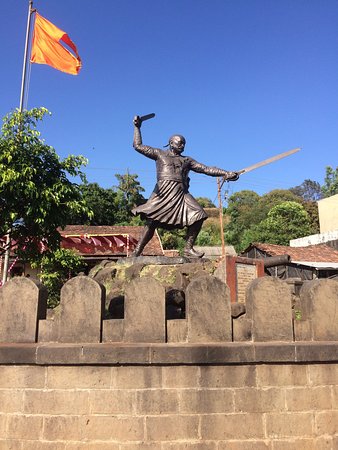
Shivaji escaped from Panhala by cover of night, and as he was pursued by the enemy cavalry, his Maratha sardar Baji Prabhu Deshpande of Bandal Deshmukh, along with 300 soldiers, volunteered to fight to the death to hold back the enemy at Ghod Khind ("horse ravine") to give Shivaji and the rest of the army a chance to reach the safety of the Vishalgad fort.[51] In the ensuing Battle of Pavan Khind, the smaller Maratha force held back the larger enemy to buy time for Shivaji to escape. Baji Prabhu Deshpande was wounded but continued to fight until he heard the sound of cannon fire from Vishalgad,[21] signalling Shivaji had safely reached the fort, on the evening of 13 July 1660.[52] Ghod Khind (khind meaning "a narrow mountain pass") was later renamed Paavan Khind ("sacred pass") in honour of Bajiprabhu Deshpande, Shibosingh Jadhav, Fuloji, and all other soldiers who fought in there.
Attacks on Shaista Khan and Surat

Upon the request of Badi Begum of Bijapur, Aurangzeb, now the Mughal emperor, sent his maternal uncle Shaista Khan, with an army numbering over 150,000 along with a powerful artillery division in January 1660 to attack Shivaji in conjunction with Bijapur's army led by Siddi Jauhar. Shaista Khan, with his better–equipped and –provisioned army of 80,000 seized Pune. He also took the nearby fort of Chakan, besieging it for a month and a half before breaching the walls.[57] Shaista Khan pressed his advantage of having a larger, better provisioned and heavily armed Mughal army and made inroads into some of the Maratha territory, seizing the city of Pune and establishing his residence at Shivaji's palace of Lal Mahal.[58] In April 1663, Shivaji launched a surprise attack on Shaista Khan in Pune, along with a small group of men. After gaining access to Khan's compound, the raiders were able to kill some of his wives; Shaista Khan escaped, losing a finger in the melee.[59] The Khan took refuge with the Mughal forces outside of Pune, and Aurangzeb punished him for this embarrassment with a transfer to Bengal.[60] In retaliation for Shaista Khan's attacks, and to replenish his now-depleted treasury, in 1664 Shivaji sacked the port city of Surat, a wealthy Mughal trading centre
Arrest in Agra and escape
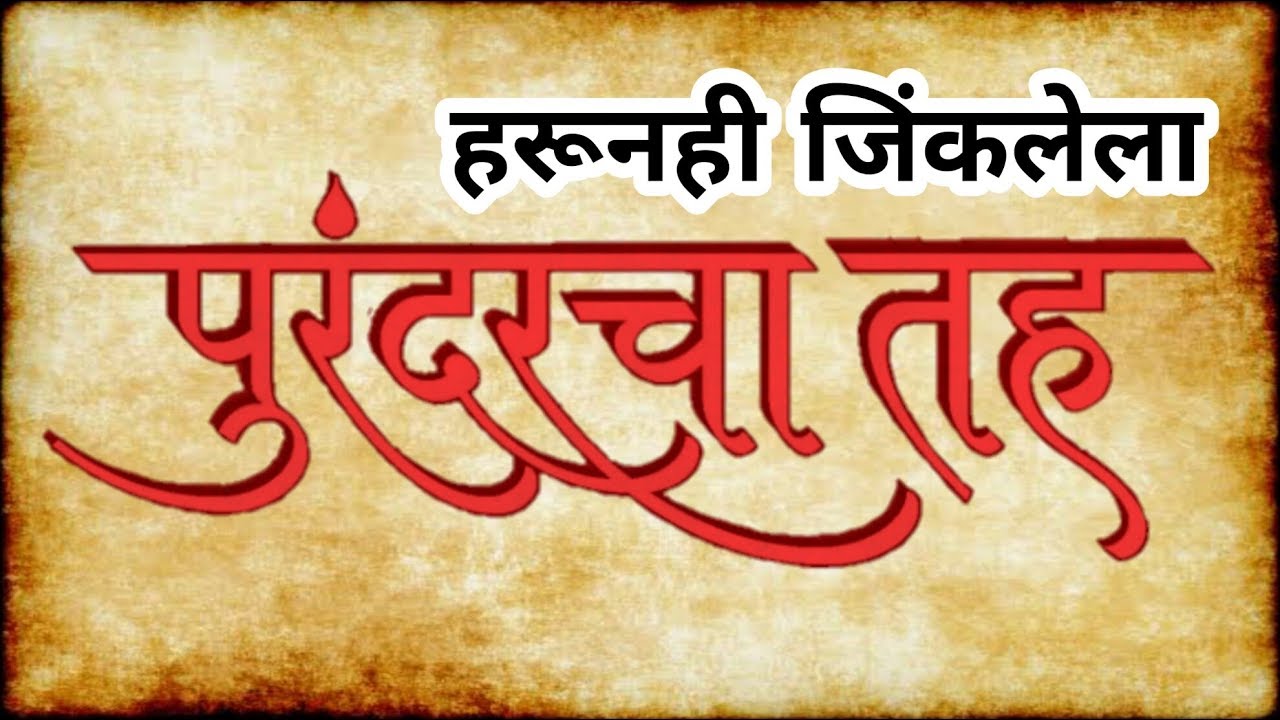
The attacks on Shaista Khan and Surat enraged Aurangzeb. In response, he sent the Rajput Mirza Raja Jai Singh I with an army numbering around 15,000 to defeat Shivaji.[62] Throughout 1665, Jai Singh's forces pressed Shivaji, with their cavalry razing the countryside, and their siege forces investing Shivaji's forts. The Mughal commander succeeded in luring away several of Shivaji's key commanders, and many of his cavalrymen, into Mughal service. By mid-1665, with the fortress at Purandar besieged and near capture, Shivaji was forced to come to terms with Jai Singh.[62] In the Treaty of Purandar, signed between Shivaji and Jai Singh on 11 June 1665, Shivaji agreed to give up 23 of his forts, keeping 12 for himself, and pay compensation of 400,000 gold hun to the Mughals.[63] Shivaji agreed to become a vassal of the Mughal empire, and to send his son Sambhaji, along with 5,000 horsemen, to fight for the Mughals in the Deccan as a mansabdar
Treaty of Purandar

In 1666, Aurangzeb summoned Shivaji to Agra (though some sources instead state Delhi), along with his nine-year-old son Sambhaji. Aurangzeb's plan was to send Shivaji to Kandahar, now in Afghanistan, to consolidate the Mughal empire's northwestern frontier. However, in the court, on 12 May 1666, Aurangzeb made Shivaji stand behind mansabdārs (military commanders) of his court. Shivaji took offence and stormed out of court,[66] and was promptly placed under house arrest under the watch of Faulad Khan, Kotwal of Agra. Shivaji's position under house arrest was perilous, as Aurangzeb's court debated whether to kill him or continue to employ him, and Shivaji used his dwindling funds to bribe courtiers to support his case. Orders came from the emperor to station Shivaji in Kabul, which Shivaji refused. Instead he asked for his forts to be returned and to serve the Mughals as a mansabdar; Aurangzeb rebutted that he must surrender his remaining forts before returning to Mughal service. Shivaji managed to escape from Agra, likely by bribing the guards, though the emperor was never able to ascertain how he escaped despite an investigation.[67] A popular legend says that Shivaji smuggled himself and his son out of the house in large baskets, claimed to be sweets to be gifted to religious figures in the city
shivrajyabhishek Sohala
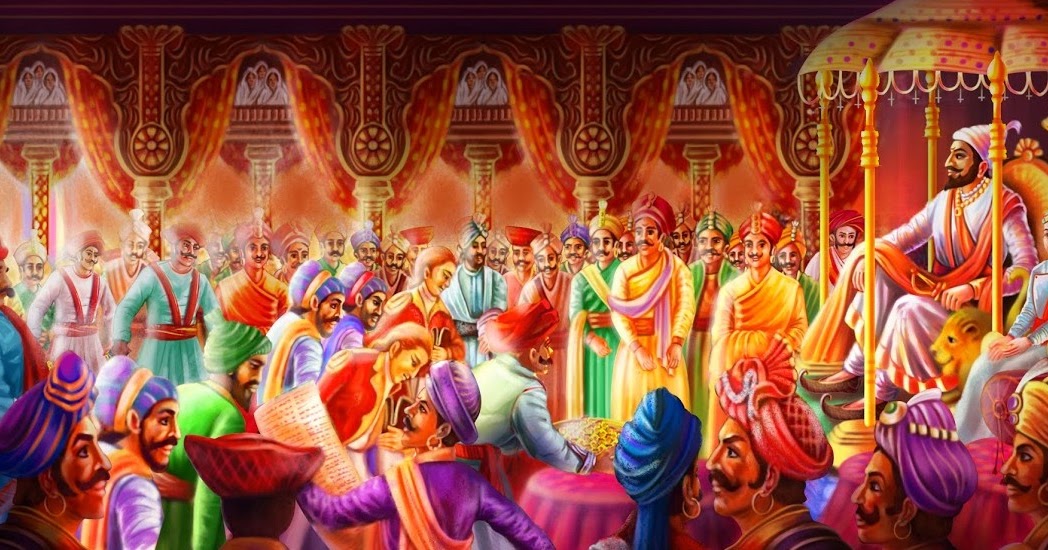
Shivaji had acquired extensive lands and wealth through his campaigns, but lacking a formal title, he was still technically a Mughal zamindar or the son of a Bijapuri jagirdar, with no legal basis to rule his de facto domain. A kingly title could address this and also prevent any challenges by other Maratha leaders, to whom he was technically equal.[d] it would also provide the Hindu Marathas with a fellow Hindu sovereign in a region otherwise ruled by Muslims.[82] The preparation for the proposed coronation began in 1673. However, some controversial problems delayed the coronation by almost a year.[83] Controversy erupted amongst the Brahmins of Shivaji's court: they refused to crown Shivaji as a king because that status was reserved for those of the kshatriya (warrior) varna in Hindu society.[84] Shivaji was descended from a line of headmen of farming villages, and the Brahmins accordingly categorised him as being of the shudra (cultivator) varna.[85][86] They noted that Shivaji had never had a sacred thread ceremony, and did not wear the thread, which a kshatriya would.[85] Shivaji summoned Gaga Bhatt, a pandit of Varanasi, who stated that he had found a genealogy proving that Shivaji was descended from the Sisodia Rajputs, and thus indeed a kshatriya, albeit one in need of the ceremonies befitting his rank.[87] To enforce this status, Shivaji was given a sacred thread ceremony, and remarried his spouses under the Vedic rites expected of a kshatriya.[88][89] However, following historical evidence, Shivaji's claim to Rajput, and specifically Sisodia ancestry may be interpreted as being anything from tenuous at best, to inventive in a more extreme reading.[90] On 28 May, Shivaji performed penance for not observing Kshatriya rites by his ancestors' and himself for so long. Then he was invested by Gaga Bhatt with the sacred thread.[91] On insistence of other Brahmins, Gaga Bhatt dropped the Vedic chant and initiated Shivaji in a modified form of the life of the twice-born, instead of putting him on a par with the Brahmins. Next day, Shivaji made atonement for the sins, deliberate or accidental, committed in his own lifetime.[92] He was weighed separately against seven metals including gold, silver and several other articles like fine linen, camphor, salt, sugar etc. All these metals and articles along with a lakh of hun were distributed among the Brahmins. But even this failed to satisfy the greed of the Brahmins. Two of the learned Brahmins pointed out that Shivaji, while conducting his raids, had burnt cities involving the death of Brahmins, cows, women and children and he could be cleansed of this sin for a price of Rs. 8,000, and Shivaji paid this amount.[92] Total expenditure made for feeding the assemblage, general alms giving, throne and ornaments approached 1.5 million Rupees.[93] Shivaji was crowned king of Maratha Swaraj in a lavish ceremony on 6 June 1674 at Raigad fort.[94][95] In the Hindu calendar it was on the 13th day (trayodashi) of the first fortnight of the month of Jyeshtha in the year 1596.[96] Gaga Bhatt officiated, holding a gold vessel filled with the seven sacred waters of the rivers Yamuna, Indus, Ganges, Godavari, Narmada, Krishna and Kaveri over Shivaji's head, and chanted the Vedic coronation mantras. After the ablution, Shivaji bowed before Jijabai and touched her feet. Nearly fifty thousand people gathered at Raigad for the ceremonies.[97][98] Shivaji was entitled Shakakarta ("founder of an era")[1] and Chhatrapati ("sovereign"). He also took the title of Haindava Dharmodhhaarak (protector of the Hindu faith).[2] Shivaji's mother Jijabai died on 18 June 1674. The Marathas summoned Nischal Puri Goswami, a tantrik priest, who declared that the original coronation had been held under inauspicious stars, and a second coronation was needed. This second coronation on 24 September 1674 had a dual-use, mollifying those who still believed that Shivaji was not qualified for the Vedic rites of his first coronation, by performing a less-contestable additional ceremony.
Expansion of Maratha Empire after chh. Shivaji
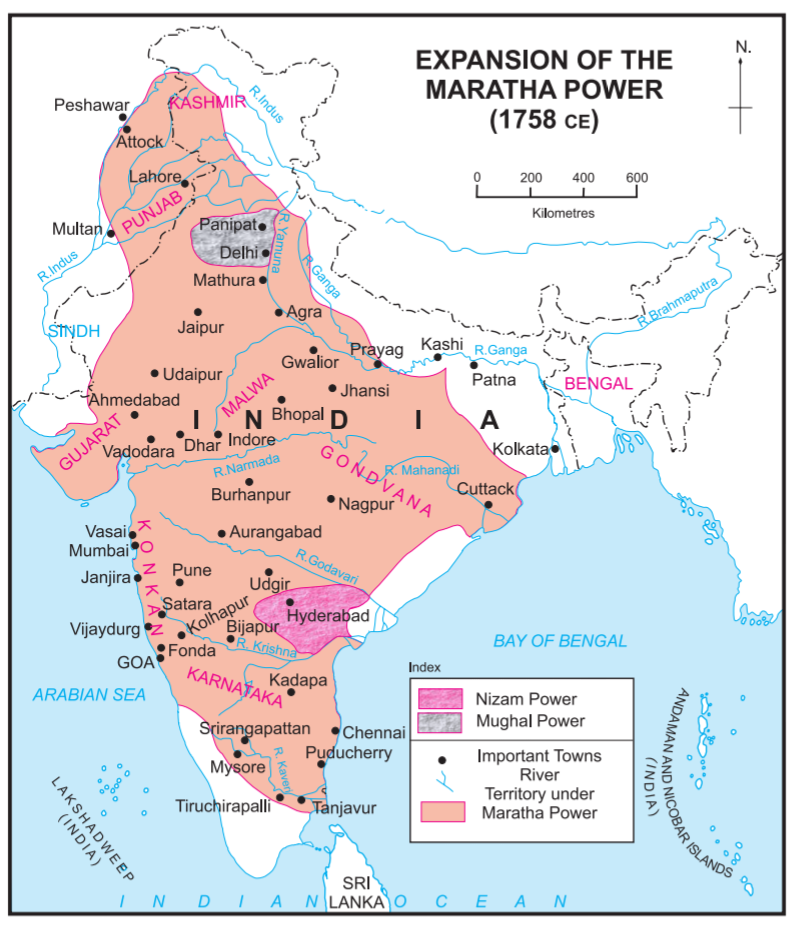
Shivaji left behind a state always at odds with the Mughals. Soon after his death, in 1681, Aurangzeb launched an offensive in the South to capture territories held by the Marathas, the Bijapur based Adilshahi and Qutb Shahi of Golkonda respectively. He was successful in obliterating the Sultanates but could not subdue the Marathas after spending 27 years in the Deccan. The period saw the capture, torture, and execution of Sambhaji in 1689, and the Marathas offering strong resistance under the leadership of Sambhaji's successor, Rajaram and then Rajaram's widow Tarabai. Territories changed hands repeatedly between the Mughals and the Marathas; the conflict ended in defeat for the Mughals in 1707.[151] Shahu, a grandson of Shivaji and son of Sambhaji, was kept prisoner by Aurangzeb during the 27-year period conflict. After the latter's death, his successor released Shahu. After a brief power struggle over succession with his aunt Tarabai, Shahu ruled the Maratha Empire from 1707 to 1749. Early in his reign, he appointed Balaji Vishwanath and later his descendants, as Peshwas (prime ministers) of the Maratha Empire. The empire expanded greatly under the leadership of Balaji's son, Peshwa Bajirao I and grandson, Peshwa Balaji Bajirao. At its peak, the Maratha empire stretched from Tamil Nadu[152] in the south, to Peshawar (modern-day Khyber Pakhtunkhwa) in the north, and Bengal. In 1761, the Maratha army lost the Third Battle of Panipat to Ahmed Shah Abdali of the Afghan Durrani Empire, which halted their imperial expansion in northwestern India. Ten years after Panipat, Marathas regained influence in North India during the rule of Madhavrao Peshwa.[153] In a bid to effectively manage the large empire, Shahu and the Peshwas gave semi-autonomy to the strongest of the knights, creating the Maratha Confederacy.[154] They became known as Gaekwads of Baroda, the Holkars of Indore and Malwa, the Scindias of Gwalior and Bhonsales of Nagpur. In 1775, the East India Company intervened in a succession struggle in Pune, which became the First Anglo-Maratha War. The Marathas remained the pre-eminent power in India until their defeat by the British in the Second and Third Anglo-Maratha wars (1805–1818), which left the Company the dominant power in most of India